This spring, however, Gadison, a Tulane School of Liberal Arts graduate student in the Department of Anthropology, stayed right here in southeast Louisiana.
Using ground-penetrating radar, she surveyed a site in Thibodaux where a sugarcane labor strike was halted on Nov. 23, 1887. White vigilantes had rounded up striking African-American workers, killing many of them.
Estimates of the number of workers who were murdered range from 30 to 60. The bodies were thrown into one grave; in the decades following the event the site became the city dump, Gadison said.
Although a strong oral history exists, especially in the black community, the event had largely been repressed from written records—until the publication of The Thibodaux Massacre: Racial Violence and the 1887 Sugar Cane Labor Strike (The History Press, 2016) by John DeSantis.
Now Gadison is a consultant on the project, working with a professor from the University of Louisiana–Lafayette to decide the next step. From her pending report based on analysis of the ground-penetrating radar survey, Gadison will recommend if, where and how to excavate.
Like relatives of murdered people interred in mass graves around the world, the Thibodaux community wants a “proper burial” for the victims, Gadison said.
She recalled that in the first forensic anthropology class in which she ever enrolled, the professor presented a photograph of a mass grave in Iraq, in which a hundred people were buried. “It was very fresh. People were recently murdered, not skeletonized. Just seeing the pit … I couldn’t understand. It was horrible. Ever since, I have that image in my mind.”
At that point, Gadison decided to focus on large-scale events and human rights violations as a forensic anthropologist.
While surveying the Thibodaux site in May, Gadison visited a barbershop next to the American Legion building located near the site. The barber told Gadison that he’d heard for years older people talk about the killing event, which apparently took place in a span of two and a half hours. “But he didn’t realize that it was actually real. That it really happened.”
Through Gadison’s efforts, though, evidence of what actually occurred should be revealed. There may be other massacre sites in the area, too, she said, which is “disturbing, very disturbing.”
“I have a passion for justice,” Gadison added. “It’s strong in me. That’s what is fueling my drive for this work.”
John Verano, professor of anthropology, is Gadison’s adviser. He has decades of experience doing excavation and analysis of human remains, most notably at ancient sites in Peru.
He said that Gadison and other anthropology graduate students whom he’s mentored and trained are impressive. “They know how to dig beautifully. They know how to analyze skeletons.”
Gadison herself is “diplomatic, savvy and self-reliant”—essential traits in the field in often remote areas of the world. As she tracks the disappearances of people, she’s letting the dead speak, really. “This is important public service,” Verano said.
Through Gadison’s efforts at the Thibodaux massacre site, she can “help to confirm that something did happen and that there was a mass grave,” he said. Then she can “identify, if possible, the general characteristics of these victims and perhaps how they died.”
Calling attention to the site will “possibly jog the memory of living people who are descendants or distant relatives of these people,” Verano said.
Earth Beneath Dump Site Offers Clues to Racial Massacre
From Somaliland to El Salvador, Peru to Guatemala, Davette Gadison has brought her passion for justice to her studies in forensic anthropology—drawn to mass gravesites in countries torn apart by civil war.
From Somaliland to El Salvador, Peru to Guatemala, Davette Gadison has brought her passion for justice to her studies in forensic anthropology—drawn to mass gravesites in countries torn apart by civil war.
“It gives visibility to things such as the Thibodaux massacre that many people never heard of. It was forgotten and buried in history.”
John Verano, professor of anthropology
The outcome will be to “finally, ideally, give them a proper burial as all humans want proper mortuary treatment of their relatives.”
Gadison’s work is “contributing to living people and bringing to light the past that they may not have known of,” Verano said. “It gives visibility to things such as the Thibodaux massacre that many people never heard of. It was forgotten and buried in history.” at you can do with what there is.”
Main photo: Louisiana sugarcane workers, circa 1880s, work under harsh conditions. A sugarcane labor strike in 1887 in Thibodaux, Louisiana, ended with the killing of an undetermined number of strikers. (Photo, “Cutting sugar cane in Louisiana,” courtesy Library of Congress, photographer William Henry Jackson)































































